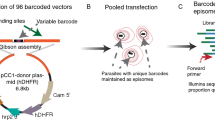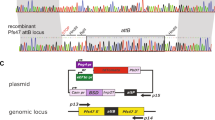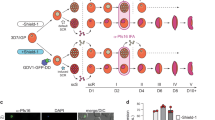Abstract
This protocol describes a method for obtaining rodent Plasmodium parasite clones with high efficiency, which takes advantage of the normal course of Plasmodium in vitro exoerythrocytic development. At the completion of development, detached cells/merosomes form, which contain hundreds to thousands of merozoites. As all parasites within a single detached cell/merosome derive from the same sporozoite, we predicted them to be genetically identical. To prove this, hepatoma cells were infected simultaneously with a mixture of Plasmodium berghei sporozoites expressing either GFP or mCherry. Subsequently, individual detached cells/merosomes from this mixed population were selected and injected into mice, resulting in clonal blood stage parasite infections. Importantly, as a large majority of mice become successfully infected using this protocol, significantly less mice are necessary than for the widely used technique of limiting dilution cloning. To produce a clonal P. berghei blood stage infection from a non-clonal infection using this procedure requires between 4 and 5 weeks.
This is a preview of subscription content, access via your institution
Access options
Subscribe to this journal
Receive 12 print issues and online access
$259.00 per year
only $21.58 per issue
Buy this article
- Purchase on Springer Link
- Instant access to full article PDF
Prices may be subject to local taxes which are calculated during checkout


Similar content being viewed by others
References
de Koning-Ward, T.F. et al. The selectable marker human dihydrofolate reductase enables sequential genetic manipulation of the Plasmodium berghei genome. Mol. Biochem. Parasitol. 106, 199–212 (2000).
Janse, C.J. et al. High efficiency transfection of Plasmodium berghei facilitates novel selection procedures. Mol. Biochem. Parasitol. 145, 60–70 (2006).
Janse, C.J., Ramesar, J. & Waters, A.P. High-efficiency transfection and drug selection of genetically transformed blood stages of the rodent malaria parasite Plasmodium berghei . Nat. Protoc. 1, 346–356 (2006).
Menard, R. & Janse, C. Gene targeting in malaria parasites. Methods 13, 148–157 (1997).
Thathy, V. & Menard, R. Gene targeting in Plasmodium berghei . Methods Mol. Med. 72, 317–331 (2002).
Jongco, A.M., Ting, L.M., Thathy, V., Mota, M.M. & Kim, K. Improved transfection and new selectable markers for the rodent malaria parasite Plasmodium yoelii . Mol. Biochem. Parasitol. 146, 242–250 (2006).
Mota, M.M., Thathy, V., Nussenzweig, R.S. & Nussenzweig, V. Gene targeting in the rodent malaria parasite Plasmodium yoelii . Mol. Biochem. Parasitol. 113, 271–278 (2001).
Sultan, A.A., Thathy, V., Nussenzweig, V. & Menard, R. Green fluorescent protein as a marker in Plasmodium berghei transformation. Infect. Immun. 67, 2602–2606 (1999).
Natarajan, R. et al. Fluorescent Plasmodium berghei sporozoites and pre-erythrocytic stages: a new tool to study mosquito and mammalian host interactions with malaria parasites. Cell. Microbiol. 3, 371–379 (2001).
Franke-Fayard, B. et al. A Plasmodium berghei reference line that constitutively expresses GFP at a high level throughout the complete life cycle. Mol. Biochem. Parasitol. 137, 23–33 (2004).
Frevert, U. et al. Intravital observation of Plasmodium berghei sporozoite infection of the liver. PLoS Biol. 3, e192 (2005).
Amino, R. et al. Quantitative imaging of Plasmodium transmission from mosquito to mammal. Nat. Med. 12, 220–224 (2006).
Amino, R. et al. Imaging malaria sporozoites in the dermis of the mammalian host. Nat. Protoc. 2, 1705–1712 (2007).
Thiberge, S. et al. In vivo imaging of malaria parasites in the murine liver. Nat. Protoc. 2, 1811–1818 (2007).
Ono, T., Tadakuma, T. & Rodriguez, A. Plasmodium yoelii yoelii 17XNL constitutively expressing GFP throughout the life cycle. Exp. Parasitol. 115, 310–313 (2007).
Sturm, A. et al. Alteration of the parasite plasma membrane and the parasitophorous vacuole membrane during exo-erythrocytic development of malaria parasites. Protist 160, 51–63 (2009).
Stanway, R.R., Witt, T., Zobiak, B., Aepfelbacher, M. & Heussler, V.T. GFP-targeting allows visualization of the apicoplast throughout the life cycle of live malaria parasites. Biol. Cell 101, 415–430 (2009).
Graewe, S., Retzlaff, S., Struck, N., Janse, C.J. & Heussler, V.T. Going live: a comparative analysis of the suitability of the RFP derivatives RedStar, mCherry and tdTomato for intravital and in vitro live imaging of Plasmodium parasites. Biotechnol. J. 4, 895–902 (2009).
Sturm, A. et al. Manipulation of host hepatocytes by the malaria parasite for delivery into liver sinusoids. Science 313, 1287–1290 (2006).
Mueller, A.K. et al. Plasmodium liver stage developmental arrest by depletion of a protein at the parasite–host interface. Proc. Natl. Acad. Sci. USA 102, 3022–3027 (2005).
Mueller, A.K., Labaied, M., Kappe, S.H. & Matuschewski, K. Genetically modified Plasmodium parasites as a protective experimental malaria vaccine. Nature 433, 164–167 (2005).
van Dijk, M.R. et al. Genetically attenuated, P36p-deficient malarial sporozoites induce protective immunity and apoptosis of infected liver cells. Proc. Natl. Acad. Sci. USA 102, 12194–12199 (2005).
Janse, C. & Waters, A.P. In Malaria Methods and Protocols (ed. Doolan, D.L.) 311–312 (Humana Press Inc., Totowa, New Jersey, 2002).
Meissner, M., Brecht, S., Bujard, H. & Soldati, D. Modulation of myosin A expression by a newly established tetracycline repressor-based inducible system in Toxoplasma gondii . Nucleic Acids Res. 29, E115 (2001).
Armstrong, C.M. & Goldberg, D.E. An FKBP destabilization domain modulates protein levels in Plasmodium falciparum . Nat. Methods 4, 1007–1009 (2007).
Herm-Gotz, A. et al. Rapid control of protein level in the apicomplexan Toxoplasma gondii . Nat. Methods 4, 1003–1005 (2007).
Waters, A.P., Thomas, A.W., van Dijk, M.R. & Janse, C.J. Transfection of malaria parasites. Methods 13, 134–147 (1997).
Silvie, O., Goetz, K. & Matuschewski, K. A sporozoite asparagine-rich protein controls initiation of Plasmodium liver stage development. PLoS Pathog. 4, e1000086 (2008).
Acknowledgements
We thank Chris Janse and Andrew Waters for supplying GFPCON parasites.
Author information
Authors and Affiliations
Contributions
R.R.S. and V.T.H. conceived the method. A.R., S.G., S.H. and R.R.S. carried out the experiments. R.R.S., S.G. and V.T.H. prepared the paper. All authors corrected the paper.
Corresponding author
Rights and permissions
About this article
Cite this article
Stanway, R., Graewe, S., Rennenberg, A. et al. Highly efficient subcloning of rodent malaria parasites by injection of single merosomes or detached cells. Nat Protoc 4, 1433–1439 (2009). https://doi.org/10.1038/nprot.2009.172
Published:
Issue Date:
DOI: https://doi.org/10.1038/nprot.2009.172
This article is cited by
-
Generation of transgenic rodent malaria parasites by transfection of cell culture-derived merozoites
Malaria Journal (2017)
-
An ultrasensitive NanoLuc-based luminescence system for monitoring Plasmodium berghei throughout its life cycle
Malaria Journal (2016)
-
The machinery underlying malaria parasite virulence is conserved between rodent and human malaria parasites
Nature Communications (2016)
-
The hypnozoite concept, with particular reference to malaria
Parasitology Research (2011)
Comments
By submitting a comment you agree to abide by our Terms and Community Guidelines. If you find something abusive or that does not comply with our terms or guidelines please flag it as inappropriate.



